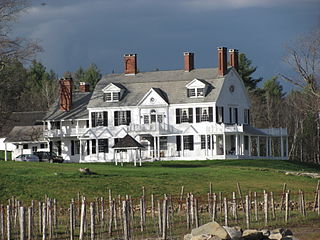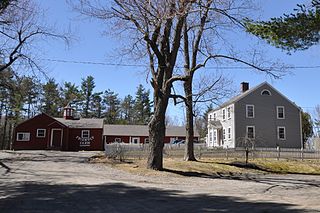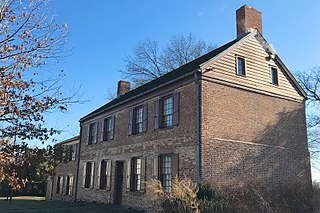
The Greene County Almshouse is a historic poorhouse located in Greene County, Illinois, along a township road northeast of the city of Carrollton. The almshouse was built in 1870 in accordance with an 1839 state law which provided for each county to establish its own almshouse or poor farm for welfare recipients. Prior to passage of the law, public welfare in Illinois had taken the form of "outdoor relief", in which the poor worked on farms in exchange for basic support. Under Illinois' county almshouse system, the poor were intended to receive shelter and necessities in the houses, often in exchange for farm labor on the property. By 1903, all but two of Illinois' counties had established an almshouse or poor farm.

The Bailey Farm is an historic farm at 373 Wyatt Road in Middletown, Rhode Island. Now reduced from more than 100 acres (40 ha) to about 45 acres (18 ha), the farm is a well-preserved example of a 19th-century island farm. It was owned by members of the Bailey family, possibly as early as the late 17th century, into the 19th century. The original main house appears to be a mid-18th century structure that was given a significant Greek Revival treatment in the 19th century. It is a 1-1/2 story Cape style house, three bays wide, with a central chimney. The main entrance is centered on the northern facade, and is flanked by sidelight windows and pilasters, with an entablature above. The corners of the building are pilastered. A series of outbuildings stand nearby. There is a second complex of buildings on the northwest part of the property, built in the 1930s near the location of the Bailey family cemetery.

Forge Farm is an historic farm in Warwick, Rhode Island. Established in the mid-17th century by the Greene family, it is one of the oldest farms in Rhode Island. It was the birthplace of General Nathanael Greene, a prominent American general in the American Revolutionary War. The core of the main house was built in 1684 by James Greene, son of John Greene, who purchased the land from local Native Americans. It has been extended and altered numerous times in the 18th and 19th centuries. Nathanael Greene was born in this house in 1742, and the farm was owned for many years by Nathanael's brother Christopher, and wife, Deborah (Ward) Greene, daughter of Continental Congress member Samuel Ward.

The Forge Road Historic District is a historic district on Forge Road from Ives Road to the Potowomut River in Warwick, Rhode Island. Most of the district's nearly 200 acres (81 ha) are taken up by the Forge Farm, which lies south of Forge Road, is one of the oldest farms in Rhode Island, and was the birthplace of American Revolutionary War general Nathanael Greene. A memorial to Greene stands near the bridge crossing the Potowomut River. Opposite the farm on Forge Road stand four houses, all of which date to the late 18th to mid-19th century.

This is a list of the National Register of Historic Places listings in Pasadena, California.

Springfield Farm is a historic home and farm located at Williamsport, Washington County, Maryland, United States. It was built in three distinct parts, with the center, or original section, dating from the second half of the 18th century. This two-story plus attic beaded clapboard house is five bays wide with an entrance in the center bay of both the first and second stories on the east façade. The property includes a springhouse and stillhouse both of rough fieldstone, and several smaller buildings. It was a home of Revolutionary War General Otho Holland Williams (1749-1794).

Brook Farm is a historic country estate farm at 4203 Twenty Mile Stream Road in Cavendish, Vermont. It includes one of the state's grandest Colonial Revival mansion houses, and surviving outbuildings of a model farm of the turn of the 20th century. It was listed on the National Register of Historic Places in 1993. The property is now home to the Brook Farm Vineyard.

The Persia Beal House is a historic house at 797 Chesham Road in Harrisville, New Hampshire. It is now the Harrisville Inn. Built about 1842, it is one of the best-preserved 19th century connected farmsteads in the town. The property is also notable for its association with Arthur E. Childs, who purchased the property to serve as the estate farm for his nearby Aldworth Manor summer estate. The house was listed on the National Register of Historic Places in 1988.

Burpee Farm was a historic farmhouse on Burpee Road in Dublin, New Hampshire, United States. Probably built in 1793, it was a good example of 18th-century vernacular farmhouse architecture, and was one of the town's oldest buildings. It was listed on the National Register of Historic Places in 1983, and was destroyed by fire in 2013.

Eveleth Farm is a historic farmstead on Burpee Road in Dublin, New Hampshire, United States. Built about 1823 and enlarged in 1980, it is a well-preserved example of an early hill farmstead, noted for its association with Henry David Thoreau, who visited the farm during a stay in Dublin in 1852. The house was listed on the National Register of Historic Places in 1983.

Gilchrest is a historic farmstead on New Hampshire Route 137 in Harrisville, New Hampshire, United States. Built in 1817, it is one of a cluster of early 19th-century hill farm Cape style houses in eastern Harrisville. It was listed on the National Register of Historic Places in 1988.

The Joseph Gowing Farm is a historic farmhouse on Page Road in Dublin, New Hampshire. Built in 1908 as part of a gentleman's farm, it is a reconstruction of a late-18th century farmhouse, and a good example of Georgian Revival architecture. The house was listed on the National Register of Historic Places in 1983.

The Asa Morse Farm, also known as the Friendly Farm, is a historic farmstead on New Hampshire Route 101 in Dublin, New Hampshire. The main farmhouse, built in 1926 on the foundations of an early 19th-century house, is a good example of Colonial Revival architecture, built during Dublin's heyday as a summer retreat. The farmstead was listed on the National Register of Historic Places in 1983.

The Stone Farm is a historic farmhouse on Old Marlborough Road in Dublin, New Hampshire. Built about 1806 with several 19th-century alterations, it is a well-preserved example of a period farmhouse. The property was listed on the National Register of Historic Places in 1983.

The Stone-Darracott House is a historic house on Old Marlborough Road in Dublin, New Hampshire. It was built in 1792 by John Stone, an early settler of Dublin for whom nearby Stone Pond is named. The house was also made part of a "gentleman's farm" by Mrs. Alberta Houghton in the early 20th century, along with the adjacent Stone Farm. The house was listed on the National Register of Historic Places in 1983.

The Oliver Whiting Homestead is a historic farmstead on Old County Farm Road in Wilton, New Hampshire, just south of the County Farm Bridge. The 72-acre (29 ha) property was one of the region's largest dairy farms in the early 19th century, and it was used as Hillsborough County's poor farm between 1867 and 1896. The main focus of the property is a large Federal-style brick house built c. 1800 by Oliver Whiting; it also has an 1846 Gothic Revival barn which predates the establishment of the poor farm. The property was listed on the National Register of Historic Places in 1982.

The Benjamin Rowe House is a historic house museum at 88 Belknap Mountain Road in Gilford, New Hampshire. Probably built in the 1830s, it is one of the town's best-preserved period houses. The house was listed on the National Register of Historic Places in 2008, and the New Hampshire State Register of Historic Places in 2003.

The Hosford–Sherman Farm is a historic farm property on Vermont Route 30 in northern Poultney, Vermont. Established in the late 18th century, the farm includes the original farmhouse, now an ell to a 19th-century brick house, and a late 19th-century barn, along with more than 120 acres (49 ha) of farmland. The property was listed on the National Register of Historic Places in 1995.

The Aaron Jr. and Susan Parker Farm is a historic farm property at 1715 Brook Road in Cavendish, Vermont. Now just 16 acres (6.5 ha), the property includes a c. 1815 Federal style farmhouse, and a well-preserved early 19th century English barn. The farmstead was listed on the National Register of Historic Places in 2014.

The Van Veghten House is a historic building in the Finderne section of Bridgewater Township, New Jersey. It was built around 1725 and served as the headquarters of Quartermaster General Nathanael Greene during the second Middlebrook encampment (1778–79) in the American Revolutionary War. The Somerset County Historical Society owns the house and uses it as its headquarters, including a museum and library. The early 18th-century Old York Road passed by here connecting Philadelphia to New York City. The house was added to the National Register of Historic Places on October 10, 1979 and noted as representing "one of the few remaining Raritan River mansions".






















